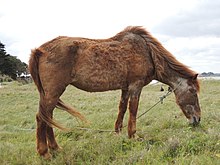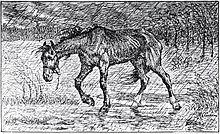
The Auxois is a horse breed from eastern France. It is a large breed, with some individuals weighing over 910 kilograms (2,010 lb), bred for horse meat, agricultural work and leisure pursuits. Overall, members of the breed are solid and muscular in appearance. They are usually bay or bay roan in color, although some other colors are accepted by the breed registry, and are known for their power and docility.

The Trait du Nord, previously also known as Ardennais du Nord or Ardennais de type Nord, is a breed of heavy draft horse developed and bred in the area of Hainaut in western Belgium and in northeastern France. Originally considered a subtype of the Ardennes, it was recognized as an individual breed with the opening of a studbook in 1903. Developed in the fertile Flemish grasslands, it was bred for size and pulling power for agricultural work. By 1855, the horses bred near Hainaut were considered by some veterinarians to be superior to other Flemish draft breeds. The Trait du Nord was used extensively in mining from the late 19th century through 1920, with lesser use continuing through the 1960s.
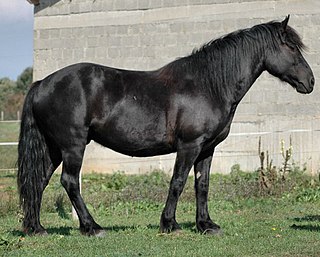
The Mérens, Cheval de Mérens or Caballo de Merens, still occasionally referred to by the older name of Ariégeois pony, is a small, rustic horse native to the Pyrenees and Ariégeois mountains of southern France, where the river Ariège flows, and northern Spain, near Andorra. Two general types, a small, light traditional mountain horse and a taller, sportier modern type, are found. Always black in color, Mérens must meet strict physical standards in order to be registered in the stud book. The breed is known for its sure-footedness on mountain terrain, as well as for its endurance, hardiness and docility. The French breed registry organizes regional offices, and partners with other national organizations in Europe to preserve and promote the breed. The organization enforces rigorous selection of breeding stock, with a goal of increasing quality in the breed. In the past, the Mérens was used for farm work, draft work and as pack horses. Today it is mainly used as a saddle horse, although some members of the breed have been successful in carriage driving. Many Mérens are taken on an annual transhumance, in which they are moved higher in the mountains during the summer and into the valleys for the winter. An old practice, it fell into disfavor, but has recently re-emerged.

The Anglo-Norman horse is a warmblood horse breed developed in Lower Normandy in northern France. A major center of horse breeding, the area had numerous regional types that were bred to one another and then crossed with Thoroughbreds to form the Anglo-Norman. Various body types developed within the Anglo-Norman breed, two of which were split off to form the Norman Cob and French Trotter. The remaining types were eventually standardized, although there remained some criticism of the "hybrid" nature of the breed's conformation. However, it is successful as an international sport horse, especially in the sport of show jumping. The Anglo-Norman also contributed to the development of several other breeds in Europe and Asia.
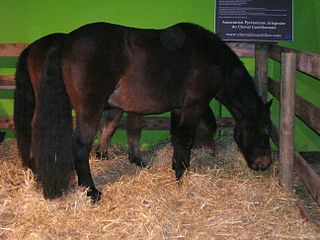
The Castillonais or Cheval Ariègeois de Castillon , also formerly called Cheval du Biros or Saint-Gironnais, is an ancient breed of small rustic saddle-horse from the Ariège département of south-western France. It may be dark bay or seal brown. It stands 135–155 centimetres at the withers, with an average height of about 145 cm. It is used principally for trekking and for driving.

Marine Oussedik, is a painter, sculptor and an illustrator specialized in horses. In 1990, she graduated from ESAG Penninghen, the Higher College of Graphic Arts, and started exhibiting in Parisian galleries the following year. Immediately afterwards she was commissioned paintings by the Living Museum of the Horse in Chantilly to be permanently displayed in two rooms. At the same time she published a book, Les chevaux d'encre. Many art books would follow including Les chevaux du Sahara in 1998, Les chevaux du vent in 2002 and Les chevaux de rois in 2003. She would be rewarded by Prix Pégase for those last two books which testify to her passion for illustrations of all kind of horses, Arabians being her favorite. In 2014, she illustrated an art book dedicated to classical French riding with texts by Guillaume Henry.
Horse cloning is the process of obtaining a horse with genes identical to that of another horse, using an artificial fertilization technique. Interest in this technique began in the 1980s. The Haflinger foal Prometea, the first living cloned horse, was obtained in 2003 in an Italian laboratory. Over the years, the technique has improved. It is mainly used on high-performance but castrated or infertile animals, for reproductive cloning. These horses are then used as breeding stock. Horse cloning is only mastered by a handful of laboratories worldwide, notably in France, Argentina, North America and China. The technique is limited by the fact that some differences remain between the original and its clone, due to the influence of mitochondrial DNA.

The Barraquand horse is a French mountain horse breed that emerged from an ancient selection process in the Vercors Massif. It is believed to have originated from a small herd of animals cultivated by Christian monastic communities, particularly those associated with the Léoncel Abbey. Named after the Barraquand family, who developed their breeding practices from the late 19th century until the 1950s, primarily through the practice of transhumance. Following the bankruptcy of the original Barraquand breeding operation and the sale of a portion of their land in 1963, the breed was considered lost. However, it has been reconstituted since the 1990s through the efforts of various breeders and local institutions, notably the Barraquand family, the Vercors Regional Natural Park, and the Annecy National Stud.

Equine-assisted therapy or equine-assisted therapy on autistic people is a therapy using a mediating horse or pony. A session can take place on foot or on horseback. Equine-assisted therapy is one of the few animal-assisted therapies regularly studied for its effectiveness, and the most popular of all autism therapies.

The horse body mass is highly variable, depending on breed, model, physiological state, condition, owner's purpose and usage of the animal. Always 65 % to 75 % water, it is divided on average between 50 % muscle, 11 % bone and 10 % fat. Depending on whether it's a pony or a draft horse, it can range from less than 200 kg to over a ton, with an average of 500 kg for saddle horses. It also differs with the season, as horses are almost always fatter in summer than in winter. Various tools are used to estimate their weight and body condition, and veterinary scales have been created to determine whether a horse has an ideal body mass according to precise criteria. Thinness is associated with mistreatment, but owner-independent factors such as age and illness can cause dramatic weight loss in horses. In Western countries, equine obesity is one of the major veterinary health problems of the 21st century. It is directly linked to numerous pathologies, such as laminitis, osteoarthritis, insulin resistance and colic. It also favors the development of equine Cushing's disease, and causes a drop in stallion fertility.

Strawberry roan, or chestnut roan, is a horse coat color consisting of a mixture of reddish-brown and white hairs in varying proportions, stable over the long term, with the head and lower limbs remaining darker than the rest of the body. Because of the wide variety of possible shades and seasonal variations, the horse coat has given rise to an abundance of poetic terminology, often inspired by the lexical field of botany, in both English and French.
Equine ethics is a field of ethical and philosophical inquiry focused on human interactions with horses. It seeks to examine and potentially reform practices that may be deemed unethical, encompassing various aspects such as breeding, care, usage, and end-of-life considerations. Central to this field is the emphasis on respect and the well-being of the horses. Key topics of debate within equine ethics include the slaughter of horses, the consumption of their meat, their legal status, zoophilia, doping in equestrian sports, the retirement of horses post-exploitation, choices regarding euthanasia, and the disposition of a horse's body after death. Additionally, there are societal calls for the recognition of horses as companion animals and increased awareness of their sensitivities.
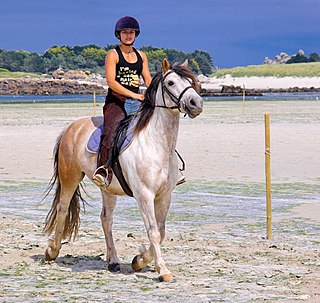
Leisure horses are intended for pleasure riding, and in particular for trail riding by private individuals. Difficult to define, it is above all an animal endowed with particular qualities, rather than a precise breed. It must be versatile and calm in character, with a willing and courageous mind. As early as the 1970s, breeders such as those of the Swiss Freiberger or Franches-Montagnes were breeding animals for this then-new use. The market for leisure horses is now buoyant. France has created "leisure qualifications" for this purpose.

In France, a municipal horse is a horse utilized for various public service tasks on behalf of a local authority. This approach aligns with sustainable development and ecological solutions, as it aims to preserve the authenticity of the sites involved. The commune of Saint-Pierre-sur-Dives was a pioneer in this practice, introducing the mare "Uranie" in 1993. The commune of Trouville-sur-Mer organizes an annual congress and leads the national municipal horse commission. In 2012, the role of coachman formally defined, and this profession was officially registered in the Répertoire national des métiers. As of 2015, approximately 300 communes of France employed one or more municipal horses. Their duties are diverse, typically involving tourism, waste management, maintenance of green spaces, safety and prevention, or personal transport.

The expression "Solutré horse" refers to the remains of prehistoric equids discovered near the Rock of Solutré by Adrien Arcelin and Henry Testot-Ferry in 1866, then studied by Professor Toussaint in 1874. This discovery gave rise to a popular legend about hunting in the abyss, according to which Paleolithic hunters guided herds of wild horses up the rock to precipitate them into the void and kill them. In reality, these migrating horses were slaughtered by men at the foot of the rock.

Horses in Morocco are an ancient tradition, linked to the history of the Berber cavalry. The Barb and Arab-Barb breeds are considered a national heritage in Morocco, having been bred by numerous local tribes. Tbourida, the most popular Moroccan equestrian sport, showcases the military use of the Barb or Arab-Barb horse. The country boasts five national stud farms in Marrakesh, Meknes, Bouznika, Oujda and El Jadida. It organizes major international equestrian events, such as the El Jadida International Horse Show and the Morocco Royal Tour, as well as national sporting events, such as the Rabat Horse Week.

Equestrianism is the third most popular Olympic sport inFrance, and the leading sport for women.

The presence of horses in Breton culture is reflected in the strong historical attachment of the Bretons to this animal, and in religious and secular traditions, sometimes seen from the outside as part of local folklore. Probably revered since ancient times, the horse is the subject of rites, witchcraft, proverbs and numerous superstitions, sometimes involving other animals.

A meat horse, or slaughter horse, is a horse bred for its ability to yield meat. Coming from draft horses formerly used for agricultural work, these horses are threatened with extinction by the mechanization of agricultural activities. This state of affairs has prompted breeders to look for new economic outlets. Breeding for meat horses was very popular in France in the 1980s, helping to safeguard these breeds. It has developed in Italy and Spain, but is declining in France, due to the further reduction of work activities with draft horses.

Equine intelligence, long described in myths and anecdotes, has been the subject of scientific study since the early 20th century. The worldwide fascination for clever horses, such as Clever Hans, gave rise to a long-running controversy over the cognitive abilities of this species. The discovery of the Clever Hans effect, followed by the development of ethological studies, has progressively revealed a high level of social intelligence, evident in horse's behavior. The scientific discipline that studies equine cognition, at the crossroads of ethology and animal psychology, is cognitive ethology.
